Exploring Safety and Well-being in Autism
This article delves into the complex relationship between autism spectrum disorder (ASD) and injury risks, including self-injurious behavior, trauma exposure, and associated mental health challenges. It also explores how behavioral interventions, particularly Applied Behavior Analysis (ABA) therapy, can play a crucial role in improving safety and quality of life for autistic individuals.
Prevalence and Nature of Self-Injurious Behavior in Autism
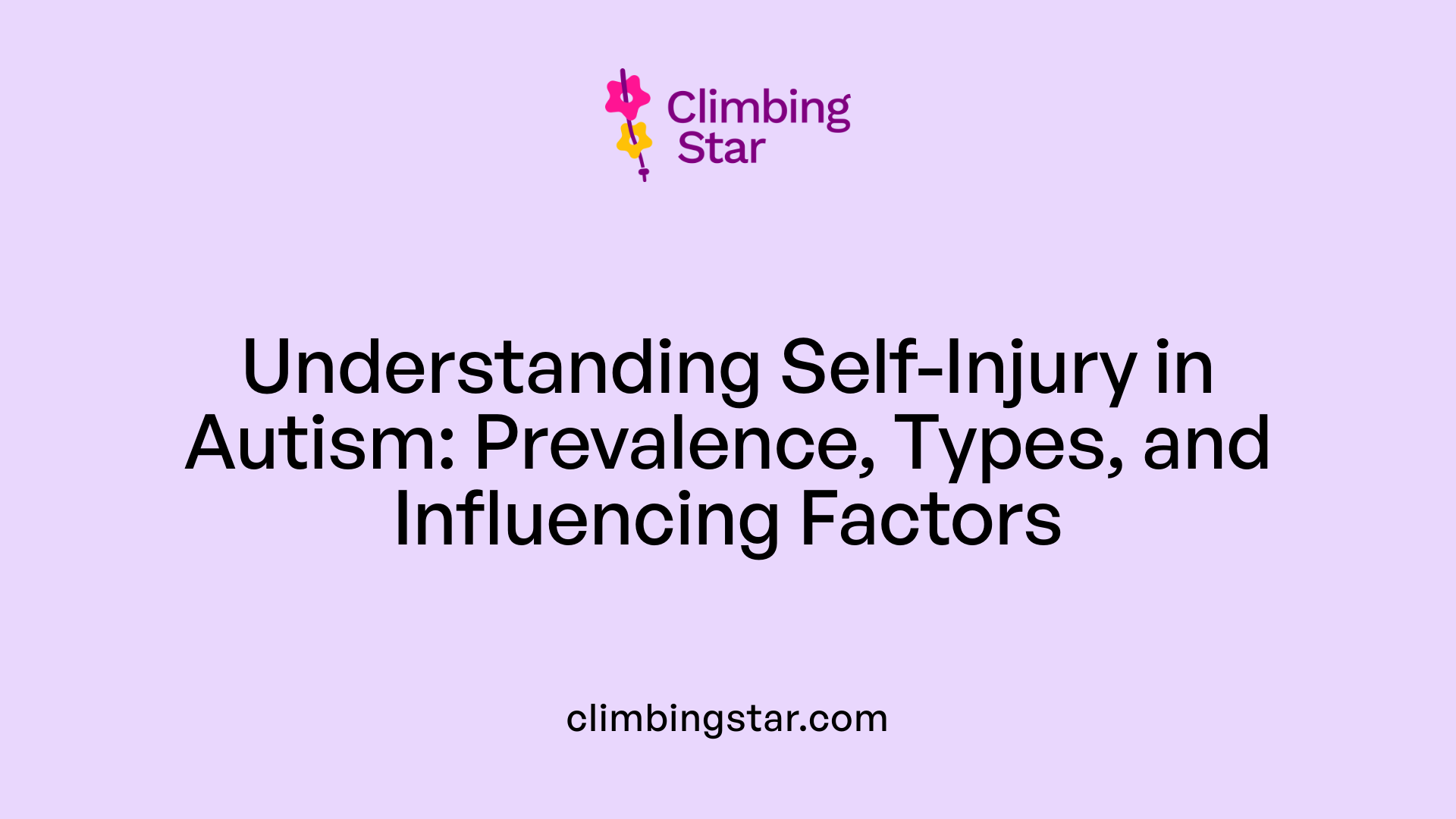
Do autistic people display self-injurious behavior more frequently?
Yes, research indicates that self-injurious behavior (SIB) is notably common in individuals with autism spectrum disorder (ASD). A meta-analysis covering 37 studies with over 14,000 participants revealed that around 42% of autistic individuals engage in self-injury. This rate highlights that nearly half of the autism population exhibits such behaviors, emphasizing its significance in clinical and support settings.
Types of self-injurious behaviors
Among the various forms of self-injury observed, hand-hitting is the most frequently reported, affecting about 23% of autistic individuals. Self-hitting is also common, though exact figures are not always specified. Less common behaviors include self-cutting, affecting approximately 3% of individuals. Other forms include biting, pinching, slapping, hair pulling, and even burning, which often relate to sensory processing challenges and emotional regulation difficulties common in autism.
Gender and age influences on SIB
Gender appears to influence the prevalence of self-injury, with females showing a higher rate compared to males, as indicated by a significant meta-regression analysis result (p = 0.013). Contrarily, age and the presence of intellectual disability do not significantly impact the overall rates of self-injurious behavior. This suggests that while sex-related factors may increase risk, SIB is a pervasive issue across different age groups and cognitive levels within the autism spectrum.
Complexity of SIB etiology
Self-injurious behavior in autism is complex, stemming from a mix of neurobiological, psychological, and environmental factors. It has been linked to impairments in adaptive functioning, communication challenges, IQ variations, sleep disturbances, atypical sensory processing, impulsivity, and overactivity. The severity of autism does not have a straightforward relationship with the presence of SIB, pointing to multifactorial causes. Due to this complexity, thorough assessment and multidisciplinary interventions are critical for effective management.
| Aspect | Details | Importance |
|---|---|---|
| Prevalence | 42% overall in autistic individuals | Highlights a high need for targeted behavioral strategies |
| Common Behaviors | Hand-hitting (23%), self-hitting, biting, self-cutting (3%) | Understanding common forms helps tailor interventions |
| Gender Influence | Higher prevalence in females | Gender-sensitive approaches may improve outcomes |
| Age/Intellectual Disability | No significant effect on prevalence | Indicates broad vulnerability across autism subgroups |
| Etiology and Influencing Factors | Neurobiology, adaptive skills, communication, sensory issues, impulsivity | Supports comprehensive, multidisciplinary intervention approaches |
Risk Factors Contributing to Injury and Self-Harm in Autism
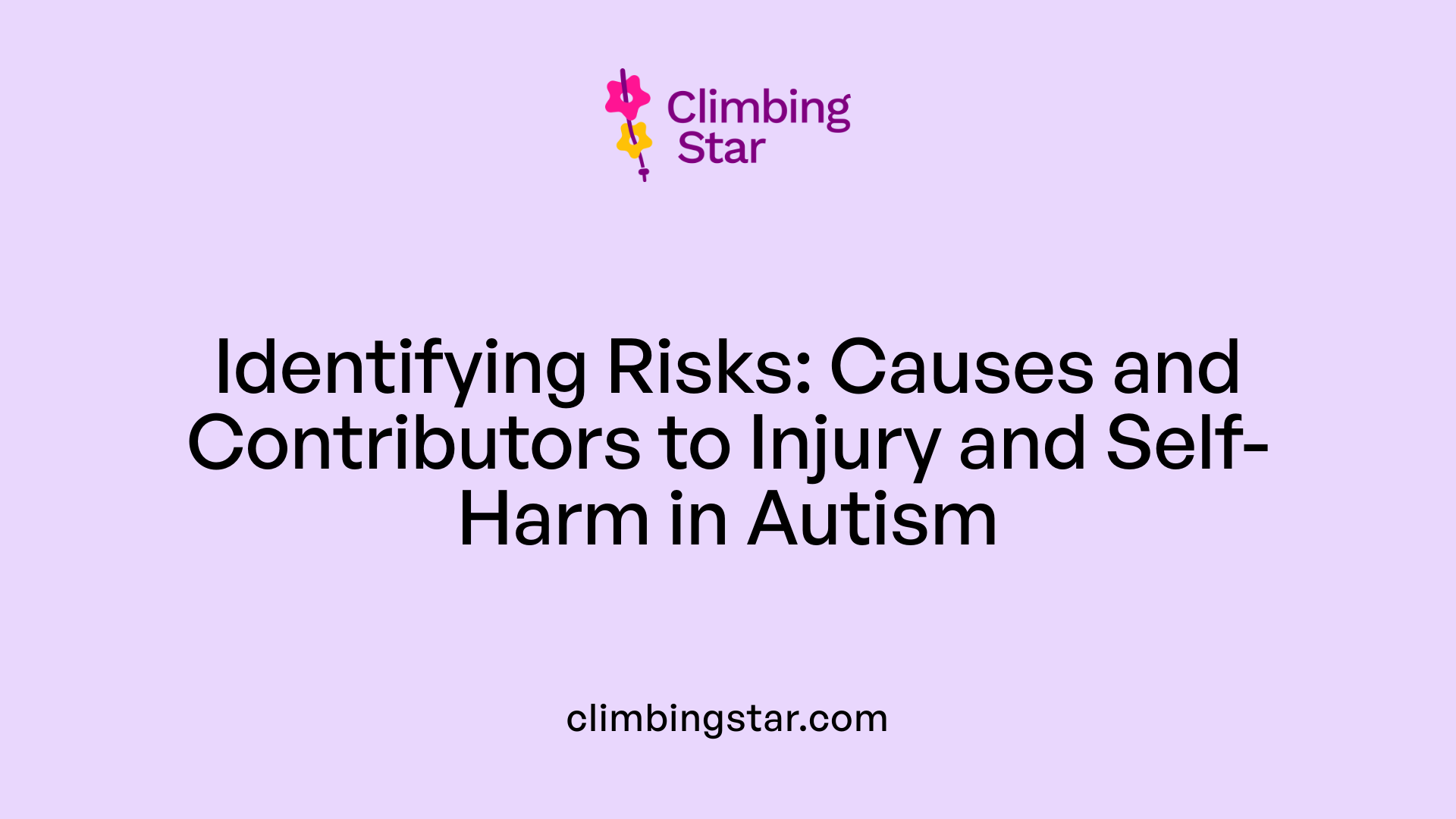
What causes or contributes to injury and self-harm in autistic individuals?
Multiple factors contribute to the increased risk of injury and self-harm seen in autistic individuals. One major trigger is challenges in communication skills, which can make it difficult for some individuals to express distress or needs, sometimes resulting in self-injurious behavior (SIB) such as hitting, biting, or cutting.
Triggers and correlates of self-injurious behavior
Self-injurious behavior in autism often stems from a complex set of factors, including impulsivity, over-activity, sleep disturbances, and atypical sensory processing. These behaviors—ranging from hand-hitting to self-cutting—may serve as coping mechanisms or responses to distress, especially in adolescence.
Impact of sensory sensitivities and communication challenges
Sensory sensitivities play a significant role in injury risk, as overwhelming stimuli can lead to frustration or anxiety that triggers SIB. Communication difficulties exacerbate this problem, limiting the individual's ability to seek help or articulate discomfort, thereby increasing the likelihood of self-harm.
Adverse childhood experiences (ACEs) and injury risk
Autistic children and teens are notably more likely to experience adverse childhood experiences, such as family disruptions and income insufficiency. These ACEs heighten vulnerability to both mental health challenges and behaviors linked to self-injury. Additionally, early learning delays increase risks like wandering away from safe areas, elevating injury possibilities.
Social and environmental contributors to injury
Environmental factors, including neighborhood violence and family challenges such as substance abuse or mental illness, also contribute indirectly to increased injury and self-harm risk. Preventative strategies often include environmental controls, behavioral interventions targeting communication skills, and community efforts to reduce adversity.
Understanding these multifaceted risk factors highlights the need for tailored, multidisciplinary interventions that address communication, sensory processing, and environmental safety to reduce injury and self-harm among autistic individuals.
Trauma and PTSD in Autistic People: Hidden Challenges
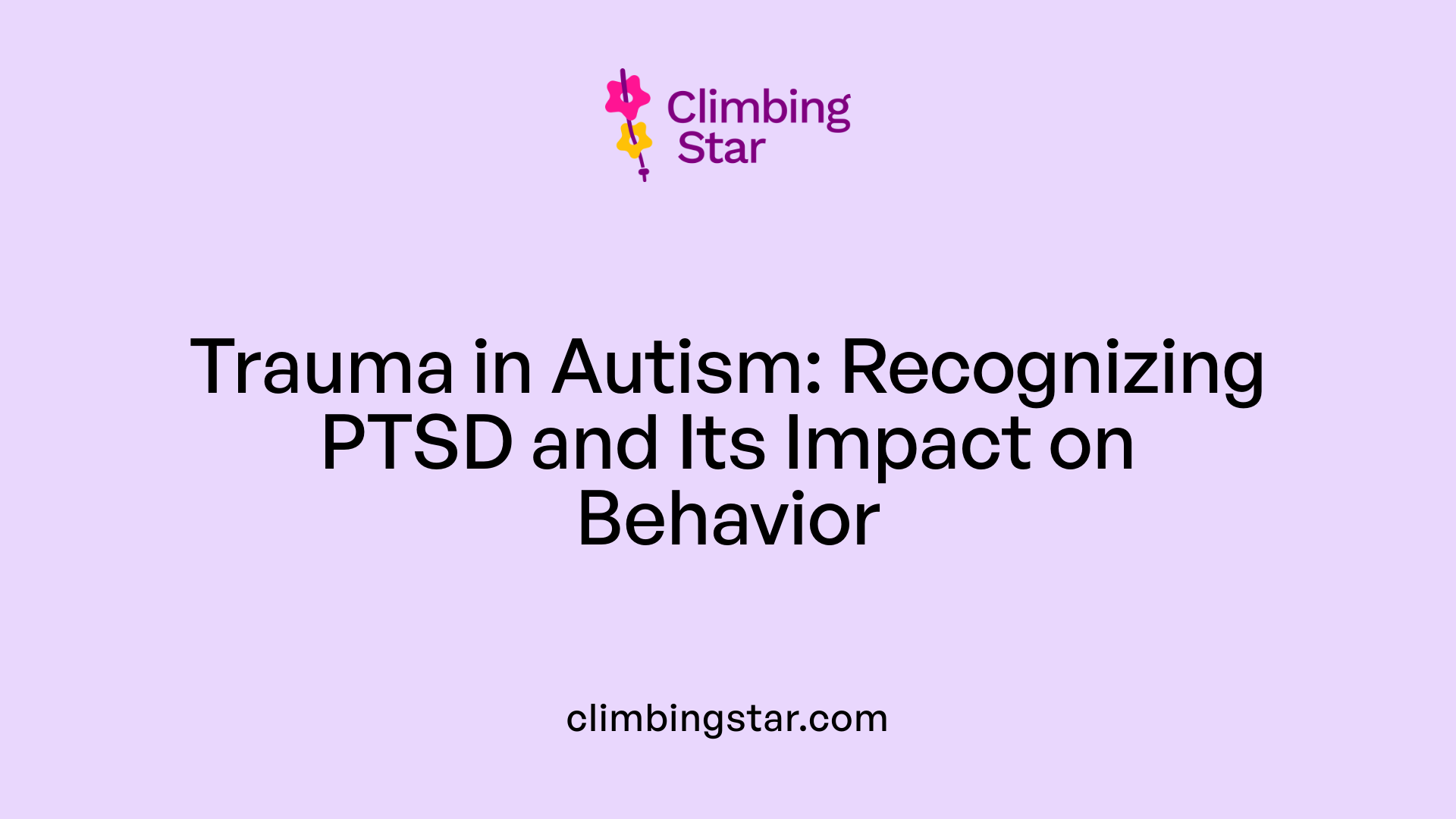
Are autistic individuals more prone to trauma and PTSD?
Yes, autistic individuals experience significantly higher exposure to adverse events compared to non-autistic populations. These include neighborhood violence, parental divorce, traumatic loss, poverty, family mental illness, and substance abuse. Adults with autism are more than four times as likely to be diagnosed with Post-Traumatic Stress Disorder (PTSD) than adults without autism.
Symptoms and underdiagnosis of PTSD
Despite this heightened risk, trauma-related symptoms in autistic people are often underrecognized and undertreated. This is partly because signs of PTSD can overlap with core autism features and other psychiatric conditions, making diagnosis difficult. Additionally, difficulties in recognizing and communicating traumatic experiences further obscure detection.
Effects of trauma on autistic features
Trauma can exacerbate core autistic traits such as social motivation and communication challenges. Reducing trauma-related stress has the potential to alleviate some of these autistic symptoms. Anxiety and depression symptoms are strongly linked with adverse events in autism, with up to 90% of autistic youth with mood symptoms reporting at least one trauma.
Importance of trauma recognition and treatment
Early identification and management of trauma in autistic individuals are crucial. Evidence supports the use of tailored trauma-specific therapies such as Eye Movement Desensitization and Reprocessing (EMDR) and Trauma-Focused Cognitive Behavioral Therapy (CBT-T). Additionally, training in emotion regulation skills complements these treatments, promoting resilience and reducing distress.
Addressing trauma effectively in autistic populations is essential to improving mental health outcomes and potentially mitigating the severity of autism-related difficulties.
Self-Injury and Suicide Risk in Autism
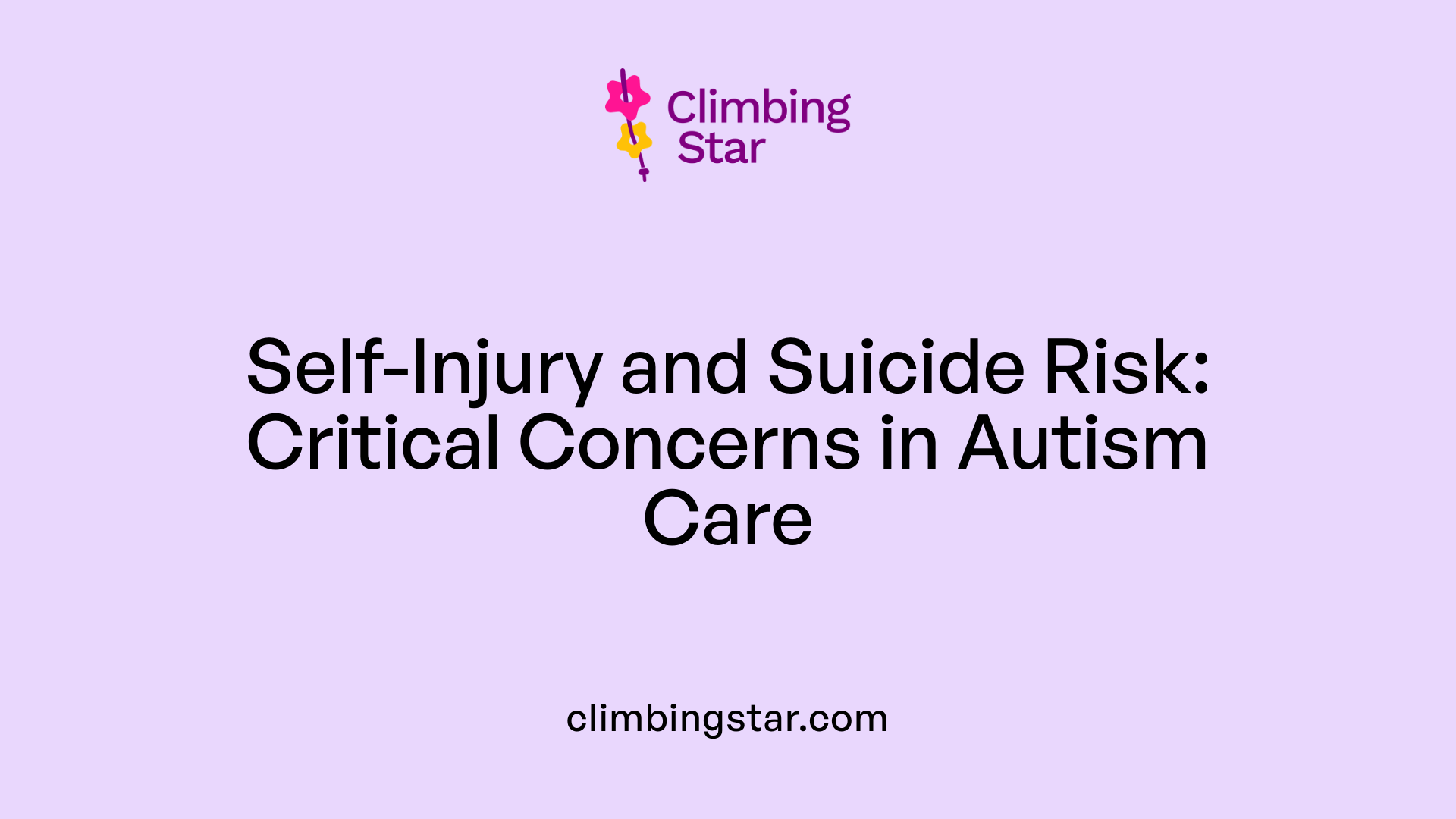
Does self-injury in autistic individuals increase suicide risk?
Self-injury among autistic individuals is strongly correlated with an increased risk of suicide. Research indicates that autistic children and adults are approximately 65% more likely to visit emergency departments for self-injury compared to their non-autistic counterparts. This heightened incidence reflects not only the frequency of self-harming behaviors such as hitting, biting, cutting, and burning but also the severity and impact of these actions on mental health.
Higher emergency department visits for self-injury
Studies show that the emergency department visitation rate related to self-injury in the autistic population is significantly elevated. This trend underscores the urgent need for effective behavioral and clinical interventions focused on preventing self-harm and mitigating its consequences. The increased visits also highlight the severity of self-injury incidents requiring medical attention and the necessity for ongoing support systems.
Mental health challenges related to self-harm
Self-injurious behaviors in autism are often intertwined with various mental health challenges, including anxiety, depression, and sensory processing difficulties. Many individuals with autism who engage in self-harm also experience trauma-related symptoms such as PTSD, which can further complicate their psychological wellbeing. The interplay between self-injury and mental health issues emphasizes the importance of tailored therapeutic approaches, such as trauma-focused therapies and emotion regulation training, to address these intertwined difficulties effectively.
Challenges Specific to Autistic Children: Wandering and Injury Risks
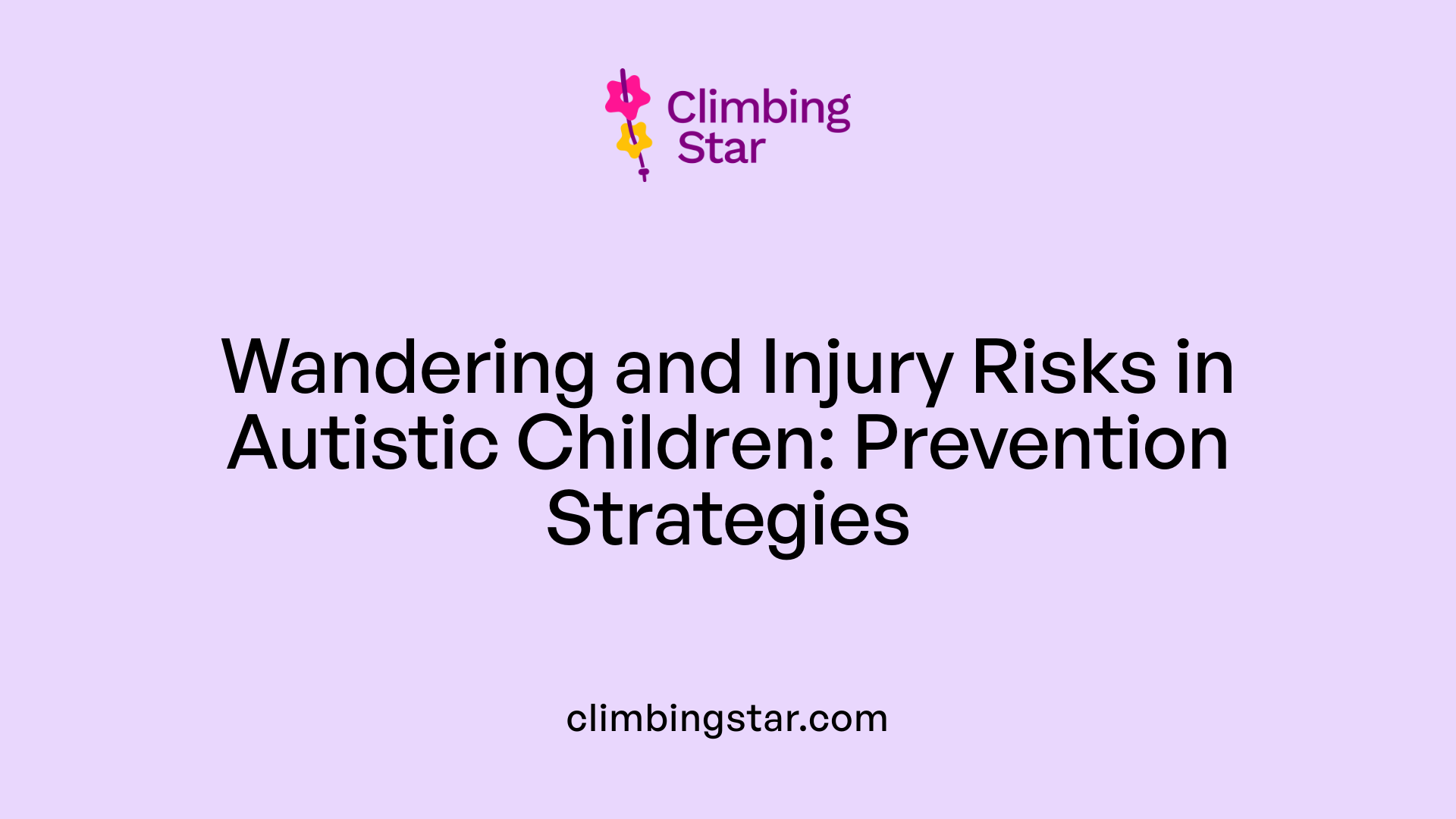
Are autistic children at higher risk of injury from wandering behaviors?
Yes, research shows that autistic children and teens are three to four times more likely to wander away from safe environments compared to their non-autistic peers. This wandering behavior significantly increases their risk of injury.
Wandering behavior and injury risk
Wandering, often termed elopement, is a common safety concern in autism. When autistic children leave secure areas unsupervised, they may encounter dangerous situations such as traffic hazards, drowning risks, or getting lost. These incidents can lead to serious injuries and trauma.
The effect of early learning delays
The risk is especially pronounced in children with significant early learning delays. These delays can reduce the child's awareness of potential dangers and limit their ability to communicate distress or seek help. Consequently, they may unknowingly put themselves in harm's way during wandering episodes.
Preventative safety concerns for children
To address these risks, a combination of environmental controls and behavioral strategies is essential. Safeguards like window guards, door alarms, fencing, and GPS tracking can help contain wandering. Behavioral interventions aim to teach communication and safety skills, identify triggers that lead to wandering, and reinforce positive behaviors.
Community and school-based programs also play a critical role by increasing awareness and providing resources to reduce adverse childhood experiences, which can compound injury risks. Collectively, these approaches strive to create safer environments for autistic children prone to wandering.
Preventative Strategies for Injury and Safety in Autism

What preventive measures reduce injury risks in autistic individuals?
Preventive strategies designed to reduce injury and enhance safety for autistic individuals focus on modifying the environment and improving behavioral responses.
Environmental safety controls
Physical measures are essential for creating safe spaces, especially for autistic children who may have tendencies such as wandering or impulsive behavior. Installing window guards, door alarms, and secure fencing helps prevent accidental injuries. These controls reduce the risk of escape and exposure to hazardous settings, thereby lowering injury rates.
Behavioral interventions to reduce self-injury
Behavioral approaches play a critical role in decreasing self-injurious behaviors common among autistic individuals. Key techniques include:
- Teaching functional communication skills to express needs and frustrations more effectively.
- Using positive reinforcement to encourage alternative behaviors.
- Identifying and managing triggers that lead to self-injury.
These strategies not only help reduce harmful actions like hitting or biting but also support emotional regulation.
Community and school-based safety initiatives
Community and educational settings serve as important platforms to enhance safety. Programs that foster awareness, offer training for staff, and implement supportive policies can substantially mitigate risks. School interventions may include individualized safety plans and accommodations tailored to the needs of autistic students.
Communication skill development
Improved communication skills are foundational to reducing injury risks. When autistic individuals better express discomfort or distress, it decreases the likelihood of frustration-induced self-harm. Therapies and training focused on language, alternative communication methods, and social skills development contribute markedly to these outcomes.
Together, these preventative measures form a comprehensive approach to injury reduction and promote wellbeing in autistic populations.
Applied Behavior Analysis (ABA) Therapy: An Overview

What is Applied Behavior Analysis (ABA) therapy?
ABA therapy is a science-based approach that uses learning principles to increase positive behaviors and reduce harmful behaviors through techniques like positive reinforcement, individualized assessment, and ongoing monitoring. It is especially effective for individuals with autism.
Definition and principles of ABA therapy
ABA therapy focuses on understanding how behavior works, how it is affected by the environment, and how learning takes place. By applying behavioral principles, ABA aims to encourage desirable behaviors such as communication and social skills, while reducing challenging behaviors including self-injury.
Assessment and individualized treatment planning
A critical aspect of ABA involves detailed assessment to identify the specific behaviors, triggers, and needs of each individual. This helps develop a personalized treatment plan that addresses unique challenges like self-injurious behaviors common in autism.
Evidence base and versatility of ABA
ABA is one of the most well-researched therapies for autism, supporting its effectiveness across ages and settings. It has demonstrated success in improving communication, adaptive skills, and reducing self-harm and other challenging behaviors.
Key techniques used in ABA therapy
- Positive reinforcement: Rewarding desired behaviors to increase their frequency
- Task analysis: Breaking complex skills into smaller steps
- Prompting and fading: Assisting then gradually reducing help as skills improve
- Data collection: Ongoing monitoring of progress to adjust treatment
These techniques collectively support individuals on the autism spectrum to improve functioning and quality of life through targeted behavioral interventions.
Benefits of ABA Therapy for Individuals with Autism
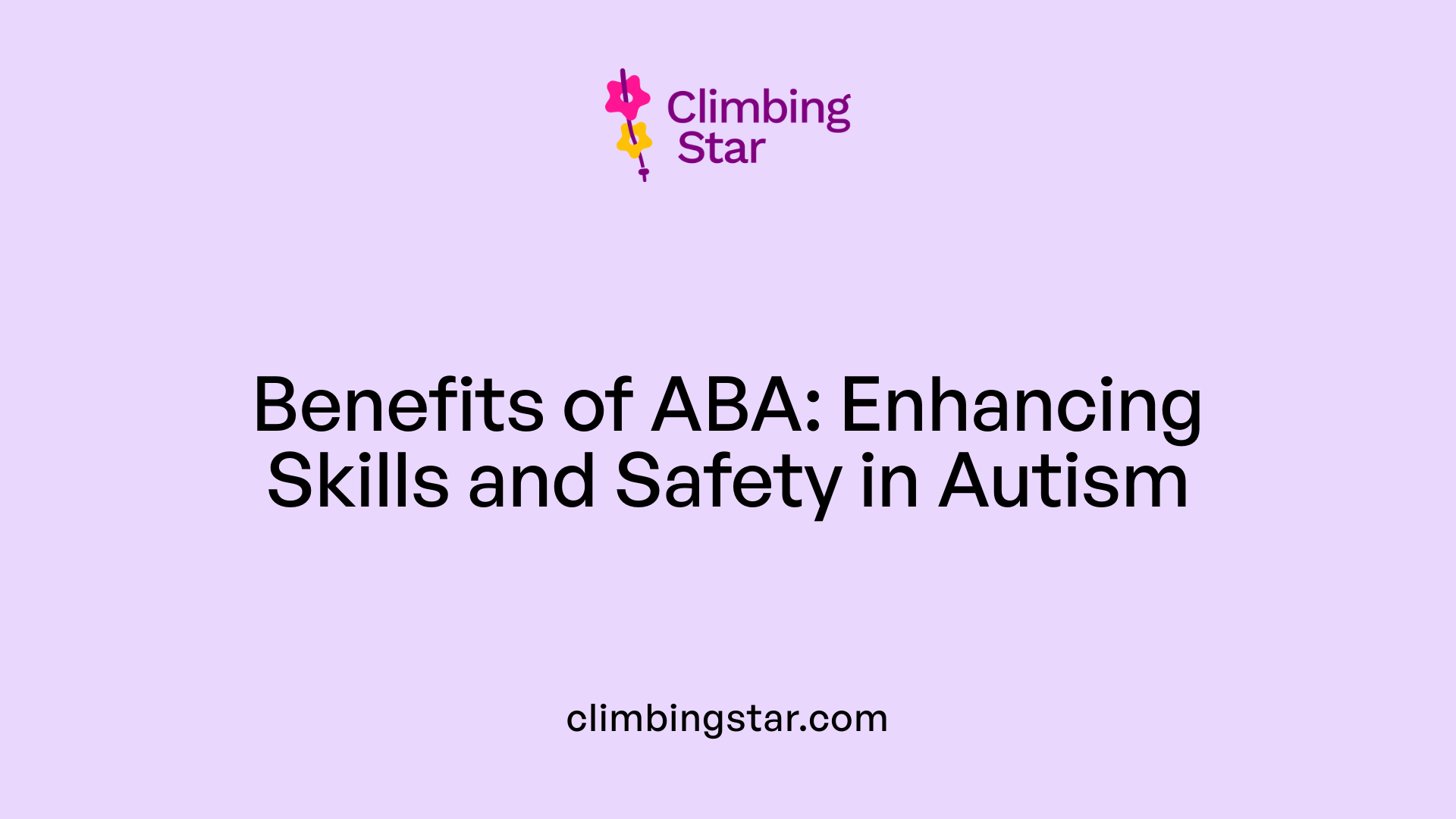
How does ABA therapy benefit individuals with autism?
Applied Behavior Analysis (ABA) therapy is a widely recognized intervention that supports skill development and behavior management in individuals with autism. By focusing on promoting positive behaviors and reducing harmful ones, ABA helps autistic individuals acquire essential communication, social, and self-care skills.
ABA therapy programs are tailored to meet each individual's specific needs, helping to boost independence and enhance social inclusion. Through consistent practice and positive reinforcement, individuals learn to navigate their environments more effectively, participate more fully in community activities, and improve their overall quality of life.
Early and intensive ABA interventions have shown particularly strong outcomes. They can reduce the prevalence of challenging behaviors such as self-injury—which affects around 42% of autistic individuals—and promote safer, healthier behavior patterns.
In addition to skill acquisition, ABA therapy encourages adaptive functioning, which is especially important given the complex interplay of factors contributing to self-injurious behaviors in autism. By addressing these behaviors early, ABA supports long-term developmental progress and emotional well-being.
Benefits of ABA therapy at a glance:
| Benefit | Description | Impact on Autistic Individuals |
|---|---|---|
| Skill Development | Enhances communication, social skills, and daily living abilities | Increases independence and functional abilities |
| Reduction of Harmful Behaviors | Decreases self-injury and other challenging behaviors | Improves safety and mental health |
| Social Inclusion | Facilitates participation in community and social settings | Enhances quality of life and reduces isolation |
| Long-Term Outcomes | Supports ongoing developmental progress and emotional regulation | Leads to better overall life trajectories |
Through systematic assessment and customized treatment, ABA therapy remains a cornerstone in supporting individuals with autism to reach their full potential.
Who Provides ABA Therapy and How Is It Delivered?

Roles of BCBAs, BCaBAs, and RBTs
ABA therapy services are delivered by a team of qualified professionals with distinct roles. Board Certified Behavior Analysts (BCBAs) hold the primary responsibility for conducting assessments, developing individualized treatment plans, and providing supervision to ensure effective intervention delivery. Board Certified Assistant Behavior Analysts (BCaBAs) implement behavior analysis services under the supervision of BCBAs, supporting the treatment goals through direct work with clients. Registered Behavior Technicians (RBTs) are frontline providers who carry out therapy by applying techniques developed by BCBAs and BCaBAs.
Supervision and Individualized Treatment Planning
Effective ABA therapy relies on ongoing supervision and tailored plans. BCBAs regularly monitor progress and adjust strategies based on data and individual needs, ensuring that interventions remain efficient and relevant. Treatment planning is highly individualized, considering client strengths, challenges, and goals to optimize developmental outcomes.
Multidisciplinary Team Involvement
ABA therapy often occurs within a broader multidisciplinary framework involving professionals such as speech therapists, occupational therapists, and psychologists. This collaboration enhances support by addressing the varied needs of individuals with autism spectrum disorder, ensuring that interventions are comprehensive and holistic.
Diverse Approaches Within ABA Therapy

Are there different approaches within ABA therapy?
Yes, Applied Behavior Analysis (ABA) therapy encompasses several distinct approaches designed to meet individual needs and goals.
Early Intensive Behavioral Intervention (EIBI)
EIBI is a comprehensive ABA approach focusing on young children, typically under age 5. It involves intensive, structured teaching sessions to promote communication, social, and adaptive skills.
Discrete Trial Training (DTT)
DTT is a structured method where skills are broken down into small, teachable units. Each trial has a clear beginning and end, using prompts and reinforcements systematically to teach specific behaviors.
Pivotal Response Treatment (PRT)
PRT targets pivotal areas such as motivation and self-management, using naturalistic teaching strategies. It aims to improve broad areas of functioning by enhancing pivotal skills in more playful and child-directed sessions.
Verbal Behavior (VB)
VB focuses specifically on language development, emphasizing communication by teaching the functional use of language, including requesting, labeling, and conversational skills through reinforcement.
Customization of approaches
ABA therapy is personalized. Clinicians select and blend these techniques based on assessments, ensuring interventions address each individual's unique strengths, challenges, and preferences for optimal skill development.
Role of ABA in Addressing Self-Injurious Behaviors

How does ABA therapy address self-injurious behaviors in autistic individuals?
Applied Behavior Analysis (ABA) therapy is a cornerstone approach in managing self-injurious behaviors (SIB) among autistic individuals. It involves several behavioral techniques specifically designed to reduce SIB and promote positive alternatives. Central methods include functional behavior assessment (FBA) to identify triggers and the purpose of self-injury, followed by the implementation of targeted interventions.
ABA uses positive reinforcement to encourage desirable behaviors while systematically reducing the frequency of self-injury. Through task analysis and prompting, ABA helps teach alternative communication methods and coping skills, enabling individuals to express needs or discomfort without resorting to harmful behaviors.
Importance of multidisciplinary assessment
Effective management of SIB requires a comprehensive, multidisciplinary approach. Due to the complexity of self-injury's causes, which may involve sensory processing issues, communication challenges, and co-occurring mental health conditions, a team including behavior analysts, psychologists, speech therapists, and medical professionals is essential. Multidisciplinary assessment ensures that interventions are tailored to the individual’s specific needs and contributes to a more holistic treatment plan.
Behavior analytic strategies for management
ABA strategies focus on identifying antecedents and consequences of self-injurious behaviors and modifying them to reduce their occurrence. These strategies include:
- Teaching functional communication skills to replace self-injury
- Using reinforcement schedules to encourage non-harmful behaviors
- Employing environmental modifications to reduce triggers
- Implementing self-management techniques to empower individuals
Such structured interventions can significantly lower the rate of self-injury and improve overall adaptive behaviors.
Long-term monitoring and intervention
Given that self-injurious behavior can be persistent and influenced by various changing factors, long-term monitoring is critical. ABA programs include ongoing data collection and periodic reassessment to adjust interventions as needed. Continuous support and maintenance help sustain progress and accommodate developmental or situational changes.
This comprehensive, dynamic ABA approach, combined with multidisciplinary collaboration, is vital for effectively addressing self-injury in autistic individuals, improving their safety, well-being, and quality of life.
Integrating Trauma-Informed Care in Autism Behavioral Interventions
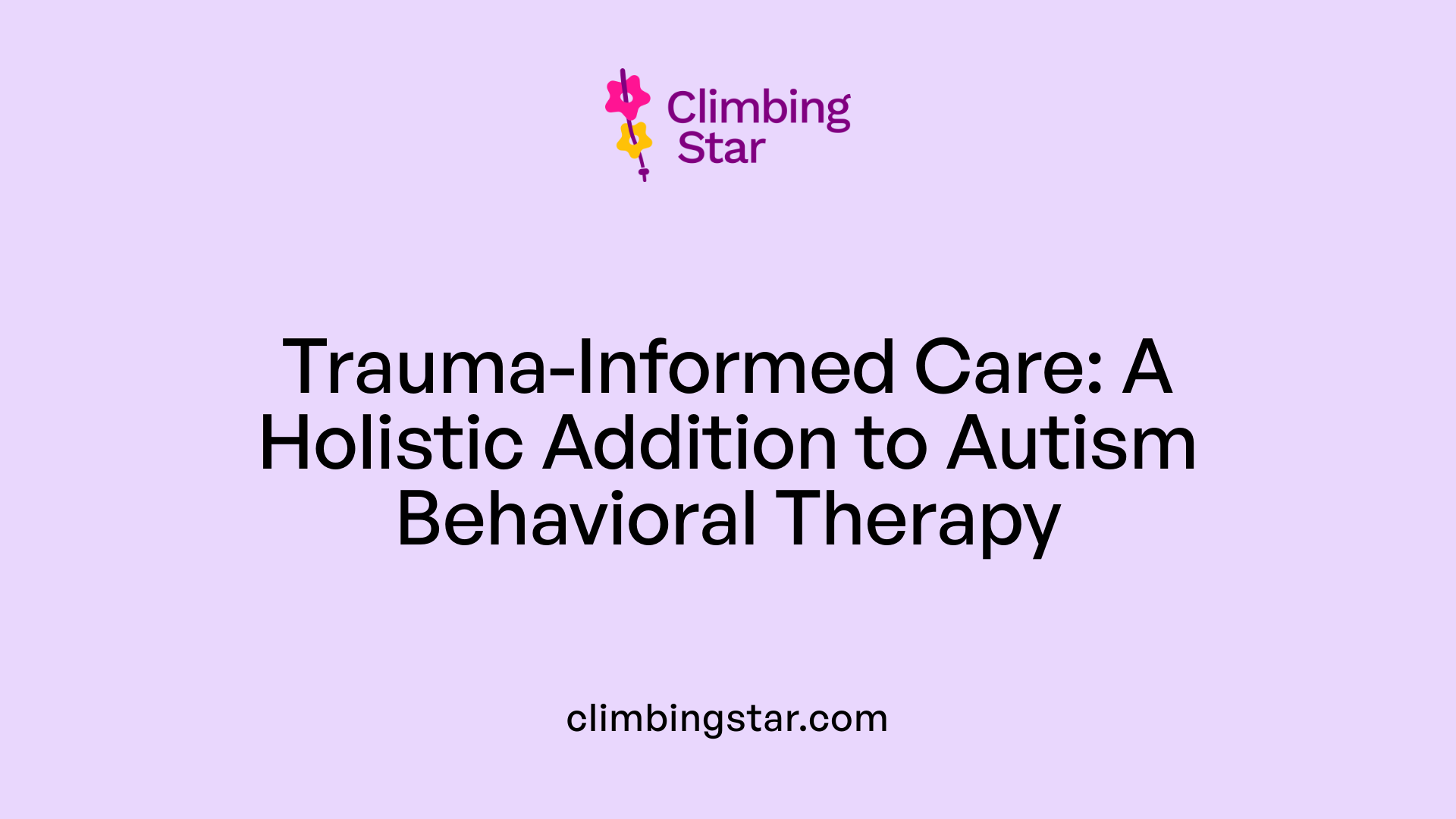
How is trauma-informed care integrated into behavioral therapies for autism?
Trauma-informed care in autism involves recognizing how adverse experiences and trauma impact behavior, including self-injurious behaviors frequently observed in autistic individuals. Given the high prevalence of trauma-related symptoms such as PTSD and anxiety, behavioral therapies increasingly incorporate trauma-specific treatments alongside traditional Applied Behavior Analysis (ABA).
Recognizing trauma's impact on behaviors
Many autistic individuals experience a higher rate of adverse events like neighborhood violence, parental divorce, and poverty, which often lead to trauma symptoms that exacerbate autistic features such as social communication difficulties and sensory sensitivities. These trauma-related stressors can trigger or worsen self-injurious behavior, making trauma recognition crucial for effective intervention.
Combining trauma treatments with ABA
To address complex behaviors, trauma-informed approaches blend evidence-based trauma treatments with ABA. Eye Movement Desensitization and Reprocessing (EMDR) and Trauma-Focused Cognitive Behavioral Therapy (CBT-T) are two therapies shown to be feasible and potentially effective for autistic individuals. When integrated with ABA, these treatments improve emotional regulation and reduce trauma-driven behaviors, which may subsequently decrease core autistic symptoms influenced by stress.
Evidence for trauma-specific therapies like EMDR and CBT-T
Preliminary research suggests EMDR can be adapted successfully for individuals with autism, helping to desensitize traumatic memories and reduce anxiety and depression symptoms. Similarly, CBT-T targets trauma-related thoughts and behaviors, supporting coping mechanisms that improve overall functioning. Both therapies complement ABA's behavior management strategies by addressing the root causes behind certain behavioral challenges.
Benefits for autistic individuals
Integrating trauma-informed care into autism behavioral interventions ensures a comprehensive, multidisciplinary approach. Early detection and treatment of trauma alongside skill development in emotion regulation contribute to better mental health outcomes and can lessen the intensity of self-injurious behaviors. This holistic approach supports autistic individuals' well-being and promotes healthier developmental trajectories.
Building Safer, Supportive Environments for Autistic Individuals
Autistic individuals face a significantly increased risk of injuries stemming from self-injurious behaviors, wandering, trauma exposure, and complex environmental and social factors. Understanding these risks highlights the critical role of effective interventions such as ABA therapy, which offers evidence-based strategies to reduce harmful behaviors and improve communication and adaptive skills. Integrating trauma-informed approaches further enhances treatment outcomes, addressing underlying stressors that exacerbate behaviors. By employing a multidisciplinary, individualized framework focused on prevention, tailored therapy, and community support, we can significantly improve safety, emotional well-being, and quality of life for autistic people across their lifespan.
References
- The Prevalence of Self-injurious Behaviour in Autism
- Autism, Adverse Events, and Trauma
- Injury and Self-Harm Present Significant Danger to Autistic ...
- Psychosocial and behavioural factors associated with self ...
- ABA Techniques: Strategies for Behavior Analysts - GSEP Blog
- Applied Behavior Analysis (ABA)
- Applied Behavior Analysis (ABA)







